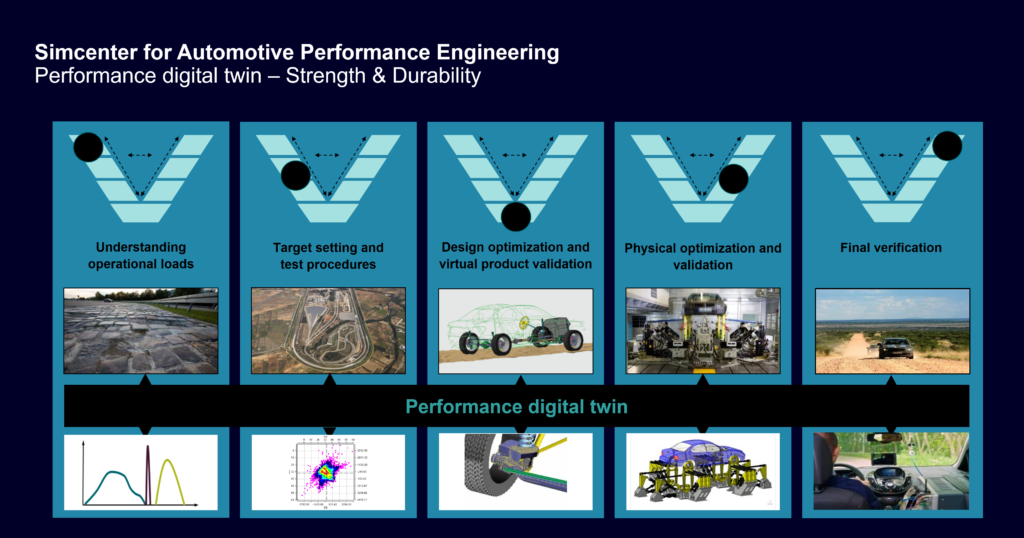The three challenges of strength and durability analysis

The ability to accurately predict strength and durability is a fundamental requirement, especially when developing electric vehicles with a heavy battery pack that alters the mass distribution and creates different loads.
Let’s follow Alessandra, who passed her final engineering exams and joined a cool startup company building electric vehicles. As an engineer like Alessandra, you strive for strong components with useful life expectancy, but you know that you must balance this aim with the cost and weight of material.
During this balancing process, you probably handle large amounts of data from various sources, but do you know how to fit all of this data together? Despite having plenty of information, you may not know which fatigue analysis method would be best for your situation.
At university, Alessandra had used some finite element tools but had not covered durability, which she associated more with physical testing and getting your hands dirty. She was left with a big question: “Where on earth can I learn about this?” You may find yourself in the same situation.
On the Siemens website, she found a webinar series addressing strength & durability in automotive applications. But which one should she watch? Let’s see what we need to learn:
Are you gaining real insight into your structure?
The test results are often stress values presented as colored images created after loads, geometry, and material data have been entered. But what does this mean for strength and fatigue? And if you also include fatigue methods, does the final result consider all the influences acting on a structure?
There is a vast difference between how loads and events act on your whole structure and how they act on individual components. Even though you have undergone a lengthy analysis process, you may need to learn which events and loads contribute to damage.
Are you caught up in a complex process?

The truth is that this type of analysis can be complicated and time-consuming, and still inaccurate.
Engineers typically face three major challenges relating to strength and durability analysis: knowing the loads, understanding specific stresses and strains, and accounting for material properties. Let’s take a look at each of these:
Challenge 1: Knowing what loads will be applied to your structure
Multiple loads are acting on a car. Each wheel is excited independently by the road surface, which means that at each point in the structure, you have a multiaxial loading situation. There are also other external influences, such as temperature and oxidation, which must be considered. To conduct an analysis, you need to know the loads, but how are you getting them? Are you able to measure them?
It is relatively easy to enter purely measured loads but what is really required is an analysis of how these loads are acting on your structure.
Challenge 2: Understanding the specific stresses and strains on a structure
To understand fatigue, you need to know the stresses and strains in your structure. How do you get from the loads you have measured or simulated on the road and the geometry of the local parts to the stresses and strains affecting your structure?
Fatigue is nearly always about notches; you need to know what is happening. There is a multiaxial load situation in a vehicle, but in the notches, there might be a stress state that is uniaxial, biaxial, or multiaxial. What is the severity of these notches, and what influence do they have? There may also be plasticity non-linearities acting on your structure – do you know what they are?
Challenge 3: Assessing how the manufacturing process affects the properties of your material
Usually, when we look at a database, we can get fatigue properties for the base material. However, before this material goes into a car, it has to go through the manufacturing process, which can create loads that influence basic fatigue properties. Surface finishes or welding during assembly create residual stresses. This influences material behavior, which means that the data you enter into your fatigue analysis may need to be completed. You can conduct experiments, but can your experiments consider all these influences?

Interestingly, research into additive manufacturing and casting shows that the properties you find in a database frequently have a considerable safety margin in highly stressed areas, where the manufacturing process and the manufacturer’s experience positively influence those properties. So, at the local level, you might see much better material behavior than expected from the global factors you entered into your analysis.

How user-friendly tools can simplify the process
The good news is that with the right tools and processes, you can learn a lot about what happens within a structure and why it happens. You can also understand more about the testing process, and then you can improve the design. You can even upgrade your whole development system.
Simple steps to faster and more accurate strength and durability analysis
The webinar explains how to break a strength and durability analysis into simple steps, investigating everything at the local level so that you know exactly what happens when it takes place and how important it is. This will lead to greater accuracy, better components, and an improved structure.
If you want to follow the next steps Alessandra took, read the blog post Easy strength and fatigue analysis for any application case: efficiently assess the strength of your component and discover the benefits of the recent additions to Simcenter 3D software.


